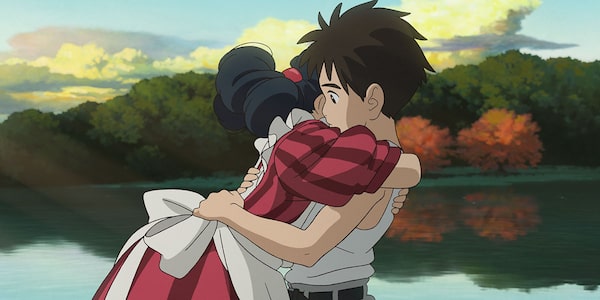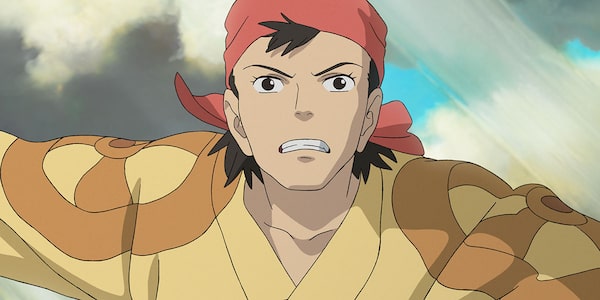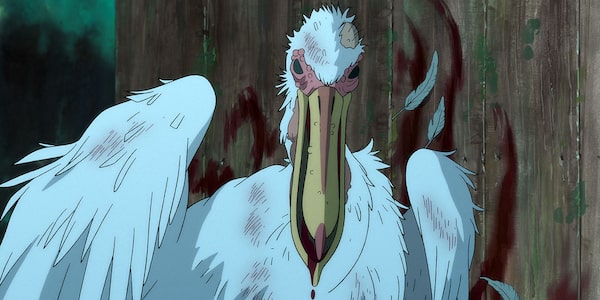
The Boy and the Heron is both beautiful and profound.TIFF
The opening night of the Toronto International Film Festival was saved by an 82-year-old Japanese filmmaker who wasn’t even in the city.
On Thursday, TIFF kicked off its 48th edition with the international premiere of The Boy and the Heron, the latest – and perhaps last – film from master animator Hayao Miyazaki. A frequently gorgeous and occasionally confounding dream of a film, the drama follows a young boy named Mahito who, after losing his mother during an Allied bombing on Tokyo during the Second World War, moves to the country with his father and new stepmother. While struggling to fit into his new surroundings, Mahito finds himself coaxed by a talking bird into exploring an alternate reality where time and space converge.
While The Boy and the Heron does not approach the cinematic highs of such past Miyazaki classics as Spirited Away, My Neighbor Totoro and Princess Mononoke, the film is both beautiful and profound. The tone can veer awkwardly from tear-stained heartache to shockingly violent darkness, and Mahito often moves from one landscape to another without purpose or explanation. But even when Miyazaki is stuffing his story with more outside-the-lines ideas than it can possibly hope to contain – including fascist parakeets, magical space rocks and unborn children called Warawara, who look like a cross between Nintendo hero Kirby and those dastardly Minions – it is clear that the film is an achingly sincere act of imagination from an artist concerned about what the world he helped build will look like when he’s gone.

TIFF bet that its audience would leave the theatre if not elated, then at least deeply impressed.TIFF
“No film shows the power of cinemas as an art form that’s both personal and global more than the one you’re about to see,” TIFF chief executive Cameron Bailey told a packed house at Toronto’s Princess of Wales Theatre ahead of the screening. “This is the most mature, dazzling expression of [Miyazaki’s] vision.”
There is a reason that Miyazaki – whose famed production company Studio Ghibli released the film with almost no promotion in Japan earlier this summer to record-breaking box-office results – was pursued so passionately by TIFF programmers for this year’s fest. Bailey travelled to Japan to watch the film in the hopes of programming it, even though Miyazaki, who rarely leaves his home country these days, wasn’t available to meet the TIFF head. There are few living legends whose mere name can draw a crowd regardless of their physical presence, and TIFF correctly bet that its audience would leave the theatre if not elated, then at least deeply impressed.
And if TIFF ever needed an opening-night sure thing, this is the year for it.
At this point, the storm clouds threatening TIFF’s sunny days are too dark and fast-moving to responsibly unpack in one column – Hollywood writers’ and actors’ strikes, corporate sponsor dilemmas, internal leadership team departures and a programming slate absent the season’s most highly anticipated premieres, including new films from Michael Mann, David Fincher, Sofia Coppola, Bradley Cooper and Yorgos Lanthimos. It is hard to host a film festival when the entire film industry is locked in an existential stalemate, and even harder when that same film festival faces its own structural reckonings.

The audience gave a Studio Ghibli executive a rapturous reception.TIFF
And then there are the inevitable glitches, slip-ups and frustrations that can happen when throwing a live event involving hundreds of thousands of people and dozens of venues. On Thursday, you could have your pick of aggrieved festivalgoers, whether it was the press and industry attendees who were turned away from all three of the day’s screenings inside Scotiabank’s IMAX auditorium because of technical errors, or the public-transit riders who encountered a blocked-off King Street West largely bereft of the high-wattage red carpets that have semi-justified such closures in the past.
But complaining about whatever TIFF gets wrong is as old a sport as the festival itself. Inside the Princess of Wales, the crowd was energized, warm, welcoming – excited to simply be out of the house, even if the biggest celebrity around was not on stage but in the audience (that would be Viggo Mortensen, taking in as many movies as he can before debuting his new directorial effort, The Dead Don’t Hurt, on Friday night).
The audience was so enthusiastic that they gave a studio executive – Ghibli’s Junichi Nishioka, who offered a few quick words ahead of the screening – a rapturous reception. (At the film’s second screening two hours later at Roy Thomson Hall, TIFF attendees got a larger burst of star power when Bailey brought out The Shape of Water director/honorary Torontonian Guillermo del Toro to rhapsodize about Miyazaki’s influence.)
Even if The Boy and the Heron didn’t spark a standing ovation, it already feels like the strongest, smartest opening-night TIFF selection in years, if not decades. Now the festival just has to pull a similar magic trick a few dozen (or hundred) more times over the next 10 days.
 Barry Hertz
Barry Hertz